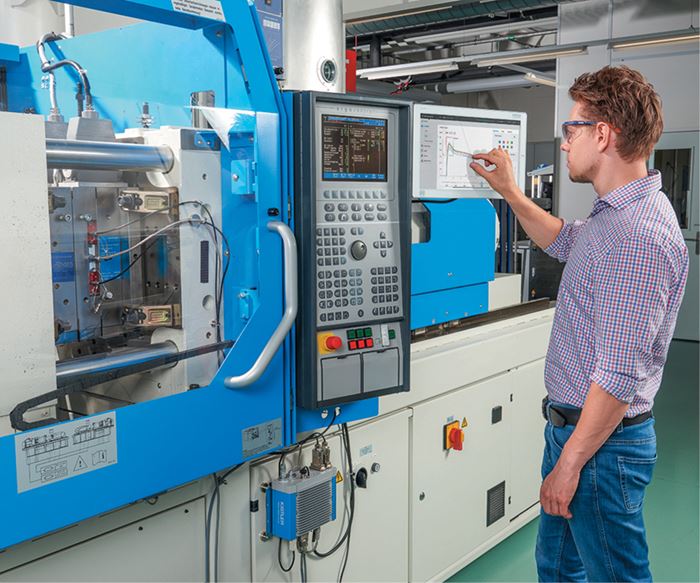INJECTION MOLDING: New Monitors, Controls, Sensors
New capabilities include the OPC-UA interface for Industry 4.0 communications.
Two well-known suppliers of injection monitoring and control systems and sensors introduced several new and upgraded products at the K 2016 show in Dusseldorf in October. The Swiss parent of Kistler Instrument Corp., Amherst, N.Y., brought out ComoNeo 2.0, a brand-new version of the ComoNeo process monitoring system introduced at Fakuma 2015 (see Feb. ’16 Keeping Up), which itself was an enhanced successor to Kistler’s Como Injection system. ComoNeo 2.0 adds automatic process control to the monitoring functions. It controls the switchover point from speed to pressure control in mold filling within each cycle, based on cavity-pressure signals, and analyzing the difference between current and reference pressure curves. The switchover point can be set manually or determined automatically by the system through analyzing a sequence of five test cycles.
Also new in ComoNeo 2.0 is a Restart Assistant, a “wizard” that helps re-establish the process after a mold is moved to a different press. It analyzes the difference between current and reference pressure curves to offer the user suggestions on how to optimize the process—for example, “Please change holding pressure to 500 bars (7255 psi).” The process is iterative, requiring a couple of test cycles.
ComoNeo 2.0 also now incorporates the OPC-UA (Open Platform Communication Universal Architecture) interface that is becoming the standard for Industry 4.0 machine-to-machine data connectivity. This enables the ComoNeo system to fully implement Multiflow control—automatic hot-runner balancing by adjusting tip temperatures—without the need for a separate PC. It also can “talk” to higher-level MES and ERP computer systems.
A second major introduction for Kistler was the ComoDataCenter 3.1, a new version of the central monitoring system for all Como Injection—and now ComoNeo—systems plantwide. It now stores all mold settings centrally. It also now offers the same user interface as ComoNeo and will translate input from older Como Injection systems to the new interface. Both types of systems are now linked by a common database. Extended functionality includes more detailed good/bad part analysis, with ability to zero in on any cycle and the pressure curve for each cavity. It also provides cpK values for the process.
Kistler also has a new piezoelectric pressure sensor, Type 6185, which measures only 2 mm frontal diam. and is insensitive to the position in which it is installed. This eliminates the susceptibility to inaccurate measurements due to mounting tolerances, making installation by moldmakers much easier and more reliable.
Kistler also brought out the Type 1722 multichannel connector, which simplifies connection of single-wire coaxial cables.
Meanwhile, Priamus of Switzerland (U.S. office in Brunswick, Ohio), showed several updated injection monitoring/control products. Under the banner of “Quality 4.0,” Priamus has added an OPC-UA interface to its FillControl systems, which allows it to transmit quality data from an entire molding cell to a network via an MES system. At the show, Priamus demonstrated this connectivity with the authentig MES system from T.I.G. of Austria, recently acquired by Engel.
Priamus also has enhanced the Q-Button on its FillControl systems. When a user has established a process that produces good parts, pushing the Q-Button automatically sets the six-sigma SPC limits for key process variables. In its latest iteration, the button establishes three levels of limits—pre-warning, warning, and alarm—to alert the user to process drift well before bad parts are produced.
A new portable FillControl system allows monitoring the process by means of a large tablet computer that plugs into the sensors on the machine and mold. All the required cables,
amplifiers, and power supply are housed in the transport case. Also new is FillControl V for automatic balancing of valve gates. It detects the arrival of the melt front via in-cavity temperature sensors, thereby detecting the different filling times from cavity to cavity. The Priamus system calculates the optimized settings of the pin stroke for every cycle and transmits them to the valve controller via an interface. FillControl V can work with the valve-gate controls of sister company Synventive Molding Solutions, another member of the Barnes Group to profile the opening speed as well as timing of the valve pins. For cold-runner LSR molding with valve gates, the Priamus system has worked successfully with the Servo Shot system of ACH Hefner of Austria.
Related Content
How to Optimize Pack & Hold Times for Hot-Runner & Valve-Gated Molds
Applying a scientific method to what is typically a trial-and-error process. Part 2 of 2.
Read MoreAre Your Sprue or Parts Sticking? Here Are Some Solutions
When a sprue or part sticks, the result of trying to unstick it is often more scratches or undercuts, making the problem worse and the fix more costly. Here’s how to set up a proper procedure for this sticky wicket.
Read MoreBest Methods of Molding Undercuts
Producing plastics parts with undercuts presents distinct challenges for molders.
Read MoreUnderstanding the ‘Science’ of Color
And as with all sciences, there are fundamentals that must be considered to do color right. Here’s a helpful start.
Read MoreRead Next
People 4.0 – How to Get Buy-In from Your Staff for Industry 4.0 Systems
Implementing a production monitoring system as the foundation of a ‘smart factory’ is about integrating people with new technology as much as it is about integrating machines and computers. Here are tips from a company that has gone through the process.
Read MoreProcessor Turns to AI to Help Keep Machines Humming
At captive processor McConkey, a new generation of artificial intelligence models, highlighted by ChatGPT, is helping it wade through the shortage of skilled labor and keep its production lines churning out good parts.
Read MoreWhy (and What) You Need to Dry
Other than polyolefins, almost every other polymer exhibits some level of polarity and therefore can absorb a certain amount of moisture from the atmosphere. Here’s a look at some of these materials, and what needs to be done to dry them.
Read More




























